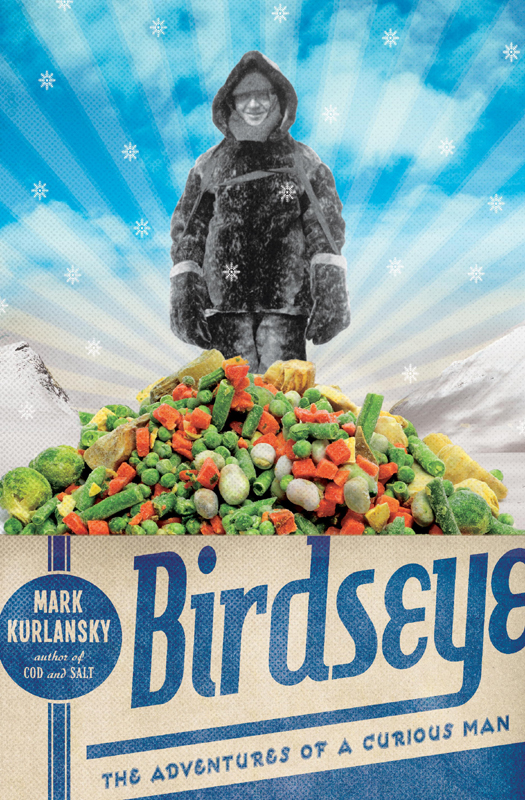
Birdseye
The Adventures of a Curious Man
کتاب های مرتبط
- اطلاعات
- نقد و بررسی
- دیدگاه کاربران
نقد و بررسی

Starred review from March 12, 2012
Although frozen foods made Birds Eye a household name, few were familiar with Clarence Birdseye (1886–1956), developer of the fast-freezing process that became a multibillion-dollar international industry. In the first biography of the eccentric Brooklyn-born inventor, award-winning food author Kurlansky (Cod) brings Birdseye to life as he outlines the twists and turns of his unusual career. In a 1945 interview Birdseye stated that G.A. Henty’s 1891 novel Redskin and Cowboy “first influenced him to live the outdoor life.” Yearning for adventure, he dropped out of Amherst College in 1908 and worked in the southwest as a U.S. Biological Survey naturalist, collected ticks in Montana to research Rocky Mountain spotted fever, and became interested in food preservation in the frozen wilderness of Labrador. Experiments with freezing led to his 1927 patent, which “truly began the frozen food industry,” yet he had to deal with the same problems Adam Trask faced in John Steinbeck’s East of Eden—distrust, since “frozen vegetables were an unheard-of idea,” and “no trucks or train cars for frozen food,” Birdseye became a millionaire when Post bought his company for $23.5 million. Covering the science behind Birdseye’s other inventions along with intimate details of his family life, Kurlansky skillfully weaves a fluid narrative of facts on products, packaging, and marketing into this rags-to-riches portrait of the man whose ingenuity brought revolutionary changes to 20th-century life. Agent, Charlotte Sheedy.

Starred review from March 15, 2012
Yes, the frozen-food guy really was named Clarence Birdseye (1886-1956), and the story of his adventures is another satisfying dish from the remarkable menu of the author of Cod (1997), Salt (2002) and other treats. Kurlansky (The Eastern Stars: How Baseball Changed the Dominican Town of San Pedro de Macoris, 2010, etc.) places Birdseye in the same category as Thomas Edison: amateurs who got curious about a problem, played around with it (sometimes for years) and eventually figured it out. Birdseye had many more interests than frozen foods, writes the author; he invented, among other things, a kind of light bulb and even a whaling harpoon. He also grew up in a world that seemed to have limitless resources--no worries about plundering the planet. He killed creatures with abandon for decades, many of which he enjoyed eating, including field mice, chipmunks and porcupine. His curiosity also made him fearless. He conducted field research on Rocky Mountain spotted fever (collecting thousands of ticks), and he lived in the frigid Labrador region of Canada (and took his equally fearless wife and their infant). It was in the North that he began to wonder why foods frozen there--naturally--tasted so much better than the frozen foods back home. He discovered, of course, that it was quick-freezing at very cold temperatures that did the trick. He eventually invented the process that produced vast amounts of good frozen food, but then had to wait for the supporting infrastructure (transportation, storage, etc.). Kurlansky tells the exciting tale of Birdseye's adventures, failures and successes (he became a multi-millionaire) and his family, and he also offers engaging snippets about Velveeta, dehydration and Grape-Nuts. The author notes that Birdseye knew that curiosity is "one essential ingredient" in a fulfilling life; it is a quality that grateful readers also discover in each of Kurlansky's books.
COPYRIGHT(2012) Kirkus Reviews, ALL RIGHTS RESERVED.

May 15, 2012
There was far more to American inventor Clarence Birdseye (1886-1956) than met the eye; he was slight and cheerful but restlessly curious. He was drawn into a life of travel to remote parts of the continent in search of adventure and new experiences. He invented tools and processes, notably that which enabled quick freezing of foodstuffs and revolutionized culinary habits. Birdseye launched not just the frozen-vegetable company that bears his now-famous name but an entire industry. Kurlansky, whose past works include the popular histories Salt and Cod, paints a complete picture of Birdseye's unusual career and accomplishments; however, this is not a gripping portrait of an individual. The lack of connection between the readers and the subject (rather than just his inventions) makes this one of Kurlansky's less-successful outings. VERDICT This is not one of Kurlansky's strongest books, but author and subject name recognition should generate interest.--Peter Hepburn, Univ. of Illinois at Chicago Lib.
Copyright 2012 Library Journal, LLC Used with permission.

April 15, 2012
Anyone who's wandered supermarket aisles recognizes the Birds Eye logo in frozen foods. But not everyone knows that the trademark originated from Clarence Birdseye, who developed a novel method for fast-freezing food that overcame earlier drawbacks of inferior taste and texture. An inveterate tinkerer, explorer, and inventor, Birdseye made a mark as a field specimen collector in the fight against Rocky Mountain spotted fever. Moving to Labrador before the start of WWI to establish a fox farm, he recognized that the deep, arctic cold kept fish tasting fresh even after thawing. He decided to replicate this discovery on an industrial level and relocated with his family to Gloucester, Massachusetts. But perfecting freezing techniques was less daunting a problem than convincing consumers of frozen food's succulence. Birdseye also had to develop shipping methods and convince railroads to upgrade their rolling stock to accommodate the icy goods. Kurlansky's narrative gifts shine through every chapter.(Reprinted with permission of Booklist, copyright 2012, American Library Association.)

























دیدگاه کاربران